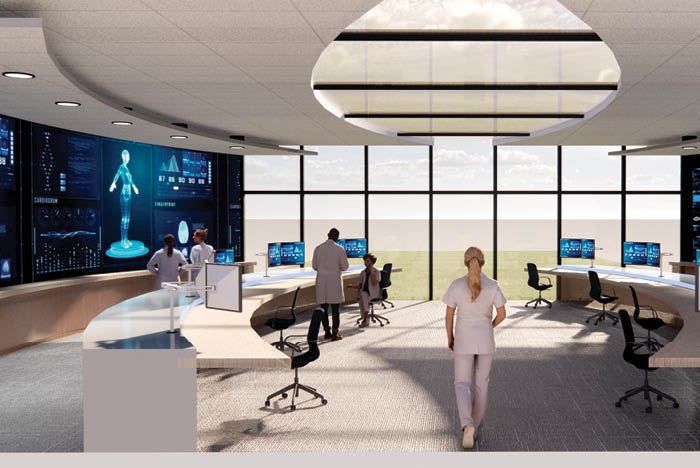Re-envisioning the hospital command center
Technology is a disrupter that has set its sights on the health care field. There are many technologies available today that have changed care delivery substantially. These advances have grown organically in the built environment, but a lack of system coordination and implementation still remains in health care designs. A design reformulation of the technology, patient safety and operations problem is needed.
To think beyond today, designers should also explore emerging job titles that will impact operations and health care designs. For instance, “surgineer” (a title that recognizes that future surgeons will also need computer science and engineering skills), “nano medic,” “avatar manager,” “3D food printer specialist,” “AI psychologist” and “genetic counselors” are just a few jobs that are anticipated. Merging these titles with the rapid development of technology will create a new health care operations model.
One possible solution is to re-envision and expand today’s “command center,” incorporating constant flow of information focused on patient monitoring and artificial intelligence. A new command center could incorporate all operations onto a “patient experience center” with all patient experience defining functions in one place. This would bring technology and the human element into the same environment.
Most current command centers focus just on using technology to improve increasing capacity and efficiency (e.g., patient tracking, bed availability, emergency department flow, reducing patient wait times, accelerating the discharge process, and tracking and improving operating room flow). Designers also must include the human aspects of the patient and family experience with clinical and safety coordination that will place the patient experience as the driver of health care improvement.
Some of the most advanced hospitals already have a version of this, but the difference is reimagining it with a decentralization of the C-suite and placing all those responsible for delivering or designing the ultimate patient experience where the action is.
What is today’s hospital command center should be transformed into an “intelligence center” where all aspects of patient care — experience, operations and technology — coexist and interact in concert. The chief experience officer space would be in the “human” module of this center; the chief information officer’s space would be in the “technology” module; and the chief medical officer’s space would be in the “clinical care coordination” cell.
This new model proposes a complete decentralization of the C-suite. It also explores centralizing clinical coordination and doing away with simply placing care team spaces in each department. Although a simple idea in concept, this health care operations center utilizes technology to provide integrated leadership focusing on the patient experience driven by patient safety and clinical outcomes with all functions in one place.





